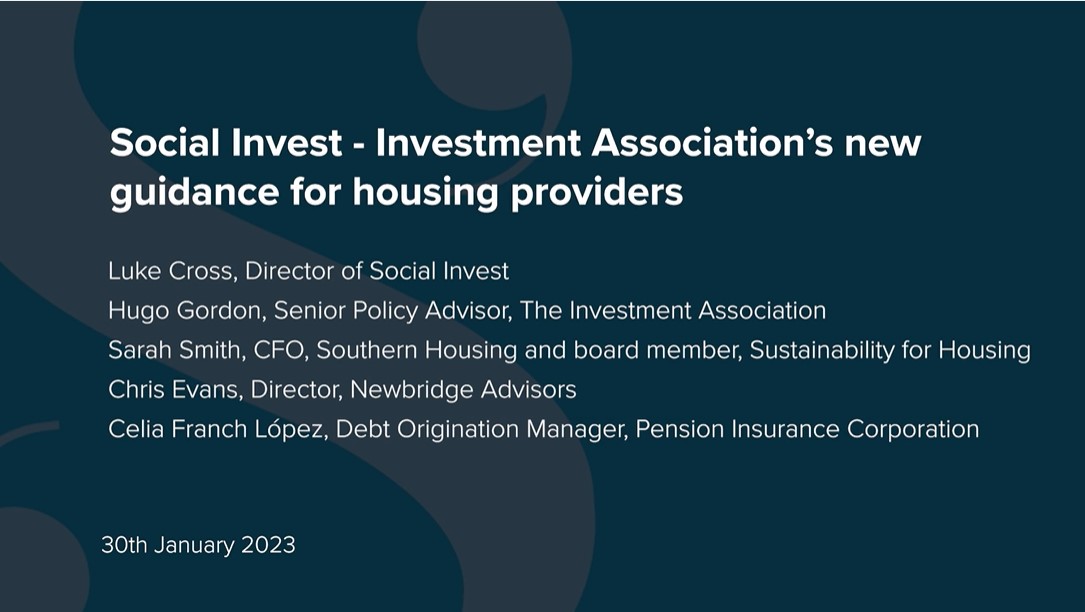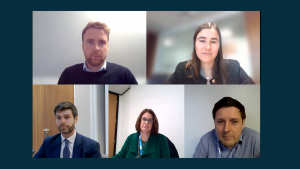Webinar: Investment Association’s new guidance for housing providers
In November 2022 the Investment Association (IA) published its updated guidance for housing associations looking to raise funds in the debt capital markets.
The membership body, which represents investors with £10trn of assets under management, expanded on its previous guidance published in 2017, with further updates around disclosures and a particular focus on environmental, social and governance (ESG).
Social Invest organised a webinar between the IA and other key stakeholders to better understand the implications of the new guidance. Below are some key talking points from the conversation:
There is appetite across the board for updated guidance
While ESG reporting continues to become more commonplace, the IA has received feedback that guidance should be expanded and honed.
Speaking at the webinar, Hugo Gordon, Senior Policy Advisor at the IA, said the updated guidance is a reflection of what investors and their clients are looking for.
What is clear is that the HA sector remains popular with investors, and more can be done by HAs to demonstrate that they are worthy of investment.
“There’s a huge amount of demand from the HA sector from IA membership,” he said.
IA guidance aims to complement SRS
Panellists noted that it is unlikely HAs would be able to meet all the updated guidance straight away and that it will be an iterative process.
Some suggested the guidance can seem overwhelming especially when considering other reporting frameworks such as the Sustainability Reporting Standard for Social Housing (SRS).
But as Chris Evans, Director at Newbridge Advisors, clarified: “The IA guidance seeks to complement the SRS” rather than add further reporting.
New timings are challenging for HAs
One of the key issues with the new guidance that was discussed was the target of publishing annual accounts within three months of the end of the financial year.
Sarah Smith, Chief Financial Officer at Southern Housing, said it is “not possible” to achieve this target at the moment due to a bottleneck in the auditing process.
Representatives from the IA and PIC said they were aware of these issues and would take them into account. They also stressed that HAs are not expected to meet all the guidance immediately.
More can be done
The panel noted that progress around ESG reporting has been excellent in the HA sector but that there are areas where data collection can be improved.
For instance, Celia Franch Lopez of the Pension Insurance Corporation (PIC), noted that data around scope 1,2 and 3 emissions remain patchy.
“One of the key challenges in the private markets is a lack of access to reliable, regularly updated carbon data,” she explained.
Further alignment
The discussion also highlighted how the IA guidance, alongside the SRS, will continue to pull in the same direction with further reporting alignment likely further down the line.
Further guidelines are expected to be produced by the Task Force on Climate-Related Financial Disclosures (TCFD) in the near future and some HAs are looking to align with these standards.
Chris Evans suggested that other organisations should look to do the same.
ESG is now a whole organisation issue
Panellists discussed the increased prominence of ESG since the last IA guidance was published in 2017. Since then, ESG reporting has become the responsibility of more teams within HAs.
Sarah Smith said: “ESG used to be a treasury function but now it is a group effort between communications teams, social impact teams and others.”
She also said that ESG reporting benefits not only residents but also employees within the organisation.
Watch the webinar in full here
Last year, Social Invest produced research into how HAs are engaging with investors. To read our full investor comms report follow the link here.
If you’d like to get in touch to discuss ESG and investor comms, please contact: luke.cross@social.co.uk



